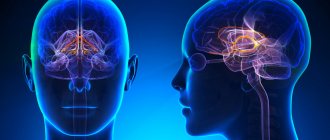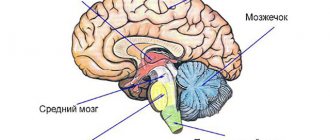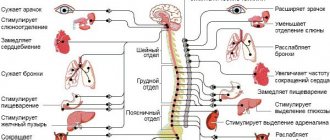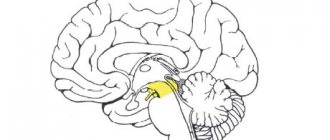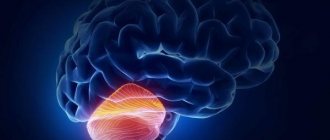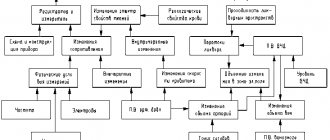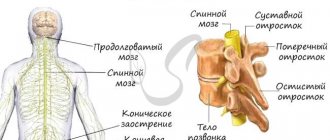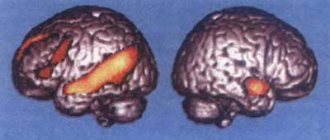Vyacheslav Dubynin about the thalamus and hypothalamus
Vyacheslav Dubynin, Doctor of Biological Sciences, Professor of the Department of Human and Animal Physiology of the Faculty of Biology of Moscow State University, a specialist in the field of brain physiology, speaks about the similarities between the thalamus and the cerebral hemispheres, hyperactivity in children and the functions of the hypothalamus.
Hypothalamus
The most important part of our brain is the diencephalon, which is so named because it is located between the cerebral hemispheres. During evolution, the cerebral hemispheres and diencephalon are formed from a structure called the forebrain. The central part of the forebrain gives rise to two processes that turn into the cerebral hemispheres, while the center remains the diencephalon. Inside the diencephalon there is a small, narrow, slit-like cavity called the third ventricle.
The diencephalon consists of two main sections: the upper half is called the thalamus, and the lower half is the hypothalamus. Their actual size is 3–4 centimeters. In addition to the thalamus and hypothalamus, there is the epithalamus, to which the pineal gland is adjacent (this is our endocrine gland, it is located in the upper rear part of the thalamus) and the pituitary gland (this is another endocrine gland, adjacent to the hypothalamus below). If we go along the stem structures of the brain, we will first come across the medulla oblongata, the pons, then the midbrain, and then we will find ourselves in the zone of the thalamus and hypothalamus. Connected to the diencephalon is the optic nerve, the second cranial nerve that enters the brain at the border of the thalamus and hypothalamus.
The thalamus is a key structure located at the entrance to the cerebral cortex. The cerebral cortex is the highest and most remarkable centers that deal with the most complex functions. In order for them to work effectively, they need to receive the right information flows in the right quantities. These functions are performed by the thalamus, which is why it is also called the “secretary” of the cerebral cortex.
The cerebral cortex contains visual, auditory, motor centers, as well as centers associated with emotions. The thalamus has the same set of centers, but only in a reduced size. There is a group of “secretaries” who help the cerebral cortex function correctly and efficiently. The thalamus can be compared to an information funnel, transmitting some signals to the cerebral cortex, and either blocking the remaining signals altogether or transmitting them in a weakened form. The problem is that the cerebral cortex cannot process the huge amount of information flows that constantly moves through our brain.
Visual centers supply visual information, auditory centers supply auditory information, memory centers remember last night, emotional centers experience emotions, motor centers want to move. The cerebellum constantly suggests to the cerebral cortex: “Let's do this! Let's do it! Why do we sit and not move, we can do so many things?” In order to really sit and not move, so that, for example, a schoolboy sits quietly in class, the thalamus must constantly block these information flows so that the cerebral cortex does not receive unnecessary exciting signals. That is, this is really an information funnel that should cut off a lot of things. The cutting occurs due to the work of inhibitory neurons, that is, in the thalamus, as well as in the cerebellum and basal ganglia, the function of gamma-aminobutyric acid (GABA) and inhibitory reactions are very important.
If the thalamus does not work well, then, for example, younger schoolchildren experience a fairly typical change in behavior called ADHD (attention deficit hyperactivity disorder). Analyze the name: attention deficit - the brain cannot hold the information channel for a long time, that is, the thalamus cannot block signals from the body, movement occurring outside the window for a long time. Therefore, the student cannot listen to the teacher for a long time, and his attention quickly dissipates. Hyperactivity is the inability to suppress for a long time those motor proposals that come from the cerebellum and basal ganglia. The student was just listening to you, but now he is spinning around, reaching into his briefcase, grabbing a textbook and throwing it at his neighbor - it’s difficult to control all this. Therefore, a truly mature thalamus is formed by the age of 8–10. And just when you are happy that everything is fine with the child and you are managing him, puberty begins, sex hormones again disrupt the functioning of the thalamus, and problems arise again.
If we go along the thalamus, we will see in it a lot of structures that correspond to different centers of the cerebral cortex. The anterior nuclei of the thalamus are nuclei associated with the transfer of information to memory centers and centers that work with emotions. Behind the anterior nuclei of the thalamus are the so-called ventral lateral, ventral lateral nuclei of the thalamus, which are associated with motor control, the anterior part of these nuclei works with the basal ganglia, and the posterior part with the cerebellum.
Next is the ventrobasal complex, which mainly carries information about the sensitivity of the body. This information is supplied to the thalamus by the spinal cord. As you know, there are neurons of the spinal ganglia, sensory neurons that collect skin and muscle sensitivity. Neurons of the spinal ganglia form bundles of axons, which, as part of the white matter of the spinal cord, without entering the gray matter, first rise to the medulla oblongata, and then go to the thalamus. These collections of fibers are called the dorsal columns, or the gracilis and cuneate fasciculi, or the gracilis and cuneate fasciculi of the spinal cord, and are very important for the conduction of cutaneous and muscular sensation. Muscle sensitivity from the spinal cord to the brain rises along two parallel pathways - to the thalamus and the cerebellum, because movement control occurs both through automated cerebellar programs and through voluntary programs generated by the cerebral cortex. The cerebral cortex, of course, needs these information flows.
Above the ventrobasal nucleus complex are the visual and auditory centers of the thalamus. The visual areas of the thalamus are very extensive, there is a pillow and the lateral geniculate body, into which the optic nerve arrives. The auditory nuclei of the thalamus are the medial geniculate bodies, they are smaller than the visual nuclei, and the main information flows come to them from the auditory nuclei of the medulla oblongata and the pons, from the nuclei of the eighth nerve.
In addition to what has already been listed, there are many other structures in the thalamus, associated, for example, with the associative zones of the cerebral cortex, and there are very well-known medial (innermost) nuclei of the thalamus, bordering the third ventricle. The medial nuclei contain clusters of nerve cells that process and transmit taste, pain signals, and vestibular sensitivity. In addition, the medial nuclei are associated with the centers of sleep and wakefulness.
There is a spinothalamic tract that comes directly from the spinal cord and ends in the medial nuclei of the thalamus. This is a specific tract, a path for pain signals. If some kind of malfunction occurs in the medial nuclei, then a pathology called chronic pain may occur, when a person constantly has pain, for example, in the thumb of his right hand. Moreover, everything is fine with the finger itself, but somewhere in the thalamus a microstroke occurred, and now a pathological pain signal arises there, preventing the person from living. This kind of pathology is not blocked by any analgesics, and in severe cases, people undergo an operation called thalamotomy, when the pinpoint zone of the medial thalamus is carefully destroyed, and then the transmission of the pathological pain signal stops.
The lower part of the diencephalon - the hypothalamus - deals with completely different tasks. The hypothalamus is oriented mainly towards the internal environment of our body. There we find nerve cells that are involved, firstly, in neuroendocrine regulation (the hypothalamus is the main endocrine center of our body). Secondly, in the hypothalamus there are neurons that are involved in autonomic regulation, that is, with the help of the sympathetic and parasympathetic systems, they control the activities of various internal organs. Thirdly, in the hypothalamus we find a number of important centers of biological needs. These three groups of hypothalamic functions are extremely important.
From the point of view of neuroendocrine regulation, it is important that the nerve cells of the hypothalamus constantly evaluate the concentration of the main hormones that are in our blood. Hormones of the thyroid gland, gonads, adrenal glands - all of these hormones are monitored by the hypothalamus. The hypothalamus innately knows how much there should be, and it has ways of conveying a signal to specific endocrine glands to secrete more or less hormones. In this case, the hypothalamus mainly influences the pituitary gland.
The endocrine system is structured on three floors. There is a specific endocrine gland, the thyroid. It secretes thyroxines - important hormones on which the overall level of activity of each cell in our body depends. In order for the thyroid gland to secrete the correct amount of thyroxine, there is a pituitary gland that secretes thyroid-stimulating hormone, and this hormone tells the thyroid gland how active it should be. But above the pituitary gland is the hypothalamus, which, with the help of its hormones called releasing hormones, tells the pituitary gland how much to secrete thyroid-stimulating hormones and ultimately change the activity of the thyroid gland. If there is too little thyroxine, the hypothalamus senses this and secretes thyroxin-releasing hormone, which causes the pituitary gland to secrete more thyroid-stimulating hormone, and the thyroid gland begins to secrete more thyroxine. Regulatory circuits of this kind are characteristic not only of the thyroid gland, but of the adrenal cortex and gonads; the release of growth hormones is controlled in a similar way.
In addition to these functions, hypothalamic neurons themselves are capable of releasing hormones directly into the blood - hormones such as oxytocin and vasopressin. Axons of nerve cells in the central zone of the hypothalamus (gray hillock of the hypothalamus) go to the posterior lobe of the pituitary gland, where oxytocin and vasopressin are released directly into the blood from these axons. Oxytocin is a known hormone that affects the contraction of the uterus during childbirth and the mammary glands when feeding a child. In addition, oxytocin is now known as a mediator of attachment. Vasopressin is a hormone that affects the functioning of the kidneys and thirst centers. Our current need for fluid depends on the concentration of vasopressin.
From the point of view of autonomic regulation, the anterior part of the hypothalamus is very important. There are thermoreceptor neurons that constantly assess the temperature of the blood flowing through the hypothalamus. If the blood is too warm, it is from the hypothalamus that reactions are triggered that reduce our body temperature. Skin blood vessels dilate and sweating begins. If the blood flowing through the hypothalamus is too cold, contraction reactions of the skin vessels are triggered, and trembling or goosebumps occur on the skin. These are all autonomic reactions that are controlled by the hypothalamus. The posterior part of the hypothalamus provides autonomic support for stress, which is also very important. Finally, the hypothalamus contains the centers of our six most important biological needs: the centers of hunger and thirst, the centers of sexual and parental behavior, and the centers of fear and aggression.
Link to source
Views: 812
Core kernels
The structure of this formation is quite complex, which is explained by the wide range of functions performed by the thalamus. The main component of the thalamus is the nucleus, formed from the gray matter of the brain, that is, the bodies of nerve cells. In total, there are about 120 nuclei in the thalamus. Depending on where they are located, kernels are classified into the following groups:
- Front.
- Lateral. The posterior part of this group, in turn, is divided into the cushion, medial and lateral geniculate bodies.
- Medial.
Depending on their functions, kernels are classified into the following groups:
- specific;
- associative;
- nonspecific.
Pathologies and their consequences
Considering the variety of functions of the thalamus and connections with different parts of the brain, the influence of its pathologies on the human body is also diverse. It depends on which nuclei are damaged and connections with which parts of the brain are disrupted. Among the frequently encountered symptoms of thalamic dysfunction in the medical literature, the following are described:
- disturbance (confusion) of consciousness and attention;
- various types of amnesia;
- violation of voluntary behavior;
- severe mental pathologies: delirium (dementia), manic disorder, etc.;
- defects in speech behavior, for example, verbal incontinence, excessive agitation, increased volume and tempo of speech, etc.;
- impaired skin sensitivity and a subjective feeling of swelling and heaviness on the side of the body opposite the affected part of the thalamus;
- severe headaches;
- muscle weakness and even paresis (paralysis).
With serious damage to the right or left parts of the thalamus, the so-called thalamic syndrome may occur, which includes a whole complex of pathologies in the side of the body that opposes the affected part:
- various types of paresis;
- violation of vibration sensitivity;
- movement coordination disorder;
- severe pain.
The causes of thalamic dysfunction are most often associated with vascular pathologies, including stroke. But disruptions to this part of the brain can also be caused by trauma and brain tumors. Treatment of thalamic pathologies and their consequences depends on the causes and nature of the lesions. If medications are ineffective, surgical intervention is also used.
Causes and risk factors
The most common causes of hypothalamic diseases are head injuries. The hypothalamus can also be affected by surgery, radiation, and tumors. In some cases, there may be a genetic link to hypothalamic disease. For example, Kallmann syndrome
(Kalmana) causes hypothalamic problems in children, in which puberty is delayed or absent and the sense of smell is impaired.
Additional causes of hypothalamic disease may include:
Eating disorders such as bulimia or anorexia;
A diet high in saturated fat;
Genetic disorders that cause excess iron accumulation in the body;
Malnutrition;
Inflammation;
Infections;
Excessive bleeding.
Dietary Tips for Hypothalamic Health
Because the hypothalamus plays such an important role in the body, it is important to keep it healthy. While genetic factors cannot be avoided, there are some dietary steps to take to maintain ideal hypothalamic health.
The hypothalamus controls appetite and is actually influenced by the foods we eat. Research has shown that a diet high in saturated fat can alter the function of the hypothalamus, which regulates hunger and energy expenditure. Sources of saturated fat include lard, meat and dairy products. A diet high in saturated fat has an inflammatory effect on the body. This can affect the immune system, increase inflammation in the gut, and alter the body's natural functioning.
A diet high in polyunsaturated fats, such as omega-3 fatty acids, may help with inflammation. These fats are a safe alternative to other types of oils and fats. Foods high in omega-3 include fish, walnuts, flax seeds and leafy vegetables.
Additional healthy food choices to support the hypothalamus include: vitamin-rich fruits and vegetables, vitamin C, and B vitamins.
The hypothalamus is very important for the body, and we do not notice it as long as it is working normally. These dietary tips will help your hypothalamus work well.
Functions of the hypothalamus
Below is a list of the main functions of this structure:
- control of the activity of the autonomic nervous system;
- organization of behavior (eating, sexual, parental, emotional behavior, etc.);
- thermoregulation of the body;
- secretion of hormones: oxytocin, which increases contractile activity of the uterus; vasopressin, which increases the absorption of water and sodium in the renal tubules.
The functions of the hypothalamus listed above are provided due to the presence in it of various centers, as well as specific nerve cells. They are able to respond to changes in the state of the body (blood temperature, water-electrolyte composition, the amount of hormones in it, glucose concentration, etc.).
Thus, the diencephalon (thalamus and hypothalamus mainly) has many important functions that make normal life activities possible.
A little about the structure
The thalamus or thalamus is represented by gray matter. These are small egg-shaped structures, their sizes reach 3-4 cm. Paired organ. The thalamus consists of the anterior tubercle, body and cushion.
The medial (middle) surfaces form the cavity of the diencephalon, the 3rd ventricle. The anterior part borders the hypothalamus, and the lateral or outer part connects the cerebral cortex with the subcortical structures of the lower sections.
The thalamus continues to be studied; its physiological significance has not been fully established.

